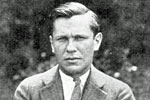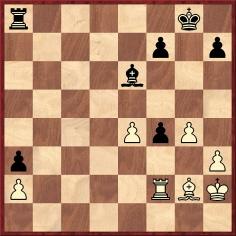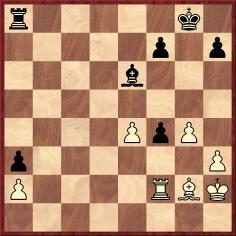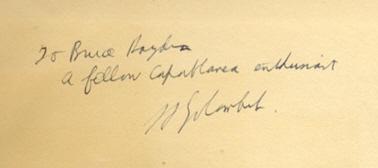Chess Explorations (43)
By Edward Winter
Capablanca played 36...f3
C.N. 2805 attempted to shed light on one of Capablanca’s most original
and fortuitous victories by quoting the full text of a letter (undated) in our
collection which was written to Bruce Hayden by the loser, Alexander Kevitz
(1902-1981). First, for ease of reference, the complete game-score:
Alexander Kevitz – José Raúl Capablanca
New York, 19 April 1931
Réti’s Opening
1 Nf3 d5 2 c4 c6 3 b3 Bf5 4 g3 Nf6 5 Bg2 e6 6 O-O Nbd7 7 Bb2 Bd6 8 d3 O-O 9
Nbd2 Qe7 10 Re1 e5 11 cxd5 cxd5 12 e4 dxe4 13 dxe4 Be6 14 Qe2 Rac8 15 Nf1 Ba3
16 Nxe5 Bxb2 17 Qxb2 Nxe5 18 Qxe5 Qa3 19 Ne3 Ng4 20 Nxg4 Bxg4 21 h3 Be6 22 Re2
Rfd8
23 Qb2 Qc5 24 Rd2 Rxd2 25 Qxd2 b6 26 Rd1 g6 27 Kh2 a5 28 Qe2 b5 29 f4 a4 30
bxa4 bxa4 31 Rd2 a3 32 g4 g5 33 Qf2 Qxf2 34 Rxf2 gxf4 35 Rf3 Ra8 36 Rf2
36...f3 37 Bf1 Rb8 38 Rxf3 Rb2+ 39 Kg3 Rxa2 40 Rc3 Ra1 41 White resigns.
The above is the score as it appears in most sources, including the tournament
book by L. Eceizabarrena Gaba and R.A. Cela, whereas the tournament book by
J. Spence had an inversion of White’s 27th and 28th moves (which is not
in keeping with Kevitz’s remark below about ‘28 Q-K2??’).
Both volumes specified the time used for the game: 2 hours 38 minutes by Kevitz
and 1 hour 41 minutes by Capablanca.
Below is the full text of the letter from Kevitz to Hayden:
‘351 W. 24 St.
New York 10011
Dear Mr Hayden,
Al Horowitz mentioned your interest in the game and your letter was expected
and welcomed.
My game with Capa represents one of very many lost opportunities but after
all these years the pain has been numbed and I think I can be objective to
annotate it in its proper perspective.
Though the opening and defense had previously been played at London, Réti
startled the chess world in the 1924 N.Y. Tournament with the ideas presented.
All the grandmasters present were favourably impressed. As a budding chess
player I was present and as a student of opening theory I was greatly influenced.
For instance though the connection may be obscure the opening defense which
has frequently been renamed in my honour viz 1 P-K4 N-QB3 is really an outgrowth
of the same Réti theory.
Capa lost a beautiful game to Réti and his theory but in a
later round Lasker managed to win with his version of the Lasker defense.
His win was erroneously (I think) attributed to correct defense and Réti’s
midgame errors were overlooked. Between 1924 and 1931 Capa frequently played
W. in the Réti and always played Lasker’s defense as B.
I had studied Réti’s management of his system and with all due
respect I thought I had improved over his handling of his own system. And
the Capa game was my opportunity to demonstrate my improvement. So to the
game.
The first nine moves arrive at the same Réti-Lasker position. By my
present day knowledge the order of moves is wrong but that is tangential.
Though some books now recommend 10 R-K1 I know and knew it to be wrong. I
played it because I was sure Capa would answer 10…P-K4. Correct is 10
PxP BPxP as Réti played it and then not 11 R-B1 but 11 P-K4, which
I have since played with devastating results.
At move 14, …P-QR4 as Lasker might have played is met by 15 Q-N5.
Capa said his 15…B-QR6 was an oversight. In that case a strange one
for him. But he also later said he couldn’t see how to meet the W. threats
which are only superficially obscure. W. threatens on say 15…R-B2 16
N-R4 followed by implantation of a N. at KB5. As variant W. also threatens
N-N5 B-N5 P-B3 B-R4 P-R4 etc. Therefore 15 P-KR3 or P-N3 is unplayable.
The play through the 22nd move seems to be errorless. Now the opinion of
the consensus that says W. should win is based on the clarified position at
W.’s 23rd move. W. is a P. ahead in an otherwise even position. The
plan should have been simply 23 P-KB4 to start a pawn storming of the B. K.
side position or a passed P. plus what K. attack develops. 23 Q-N2 was strategically
and tactically unnecessary. Nor is 23 K-R2 necessary. Capa would probably
have played 23 P-KB4 R-B4 24 Q-N2 QxQ 25 RxQ R-Q6 26 K-B2 and now even with
24…QR-B6 25 P-N4 W. could not be prevented from doubling Rs. on the
K. file. The point is that B.’s demonstration with P-QR4 could not follow
through because W. could arrive at a P-KB5 driving B.’s B. off the diagonal
before B.’s threats could mount.
26 R-Q1 is the first of a new series of weak moves stemming from clock trouble.
It is not addressed to the strategic needs. Correct is 26 K-R2 P-QR4 27 P-B4
P-N3 28 R-KB P-QN4?? 29 P-B5. Probably B. would have to play 28…Q-B7.
28 Q-K2?? is totally incomprehensible. 28 P-B4 continues to prevent …P-QN4
because of QxP.
31 R-Q2?? is again wrong preparation. Correct is 31 B-B3 and if 31…P-KR4
32 P-N4 or if 31…Q-R6 32 B-N4 or if the defensive ideas are found 31…P-R4
32 P-N4 Q-R6 33 P-B5 or R-Q2 first.
32 P-N4?? finally throws away the win. I overlooked the answer completely
and in exasperation overlooked the draw as well. 33 P-B5 Q-K4+ 34 K-R R-B8+
35 R-Q Q-N7 36 Q-Q3 BxRP 37 Q-Q8+ etc. First should have come some move like
32 B-B3.
Capa’s final combination starting with 33…QxQ was beautiful precision
and included a problem-like move 36…P-B6.
I do not pretend these annotations are complete and some of them being present
day offhand may be inaccurate or wrong. Please feel free to question them
or to attack their validity.
In any case I would be pleased to hear from you further on this or any other
question.
With best regards and good wishes.
Yours truly,
Alex Kevitz.’

In C.N. 2820 Gene Gnandt (Houston, TX, USA) commented on Kevitz’s annotations:
‘I think he is much too hard on himself. Even with Capablanca’s
36...f3!, White does not appear to be lost. After 36...f3! 37 Bf1 Rb8 …
… instead of 38 Rxf3?? why not 38 Bd3 Rb2 39 Rxb2 axb2 40 Bb1 Bc4
41 Kg3 Be2, etc.?’
In that same C.N. item we noted that the second Chess Stars volume on Capablanca,
published in 1997, also gives the above line (page 141), indicating (with symbols)
that after 42 a4 White has counter-play and stands only slightly worse.
In C.N. 4193 Karsten Müller (Hamburg, Germany) informed us:
‘Capablanca’s 36...f3 was, in fact, a mistake, violating the
important endgame principle “do not hurry”. Improving the position
of the rook and king first and playing ...f3 later to disrupt White’s
defensive coordination should win. For instance, 36...Ra4 37 g5 Kg7 38 h4
h6 39 gxh6+ Kxh6, and White is powerless against Black’s plan of bringing
the rook to b2 and infiltrating with the king (e.g. 40 Bf3 Rb4, followed by
...Rb2).’
As regards the game-score, earlier this month Olimpiu G. Urcan (Singapore)
sent us the moves as they appeared in the New York Times, 20 April 1931,
page 26 and the Brooklyn Daily Eagle, 23 April 1931, page 28. Both gave
the move sequence as 27 Qe2 and 28 Kh2:
The game was not widely published in chess magazines of the time, although
it appears in many collections of the Cuban’s greatest games, highly praised.
For example, on page 238 of Capablanca’s Best Chess Endings (Oxford,
1978) Irving Chernev called it ‘a delightful gem with a piquant finish’.
In Capablanca’s Hundred Best Games of Chess by Harry Golombek (London,
1947) 36...f3 was described as ‘a potent move that makes the game resemble
an endgame study’ (or ‘a composed endgame’ in the 1996 Batsford/Nunn
edition).
One of our copies of the original edition of Golombek’s book is inscribed
to Bruce Hayden:
We conclude with a photograph of Alexander Kevitz, from page 44 of the March
1929 American Chess Bulletin:
Capablanca articles by Edward Winter:
Submit information
or suggestions on chess explorations
All ChessBase articles
by Edward Winter
 Edward
Winter is the editor of Chess
Notes, which was founded in January 1982 as "a forum for aficionados
to discuss all matters relating to the Royal Pastime". Since then, over 6,650
items have been published, and the series has resulted in four books by Winter:
Chess
Explorations (1996), Kings,
Commoners and Knaves (1999), A
Chess Omnibus (2003) and Chess
Facts and Fables (2006). He is also the author of a monograph
on Capablanca (1989).
Edward
Winter is the editor of Chess
Notes, which was founded in January 1982 as "a forum for aficionados
to discuss all matters relating to the Royal Pastime". Since then, over 6,650
items have been published, and the series has resulted in four books by Winter:
Chess
Explorations (1996), Kings,
Commoners and Knaves (1999), A
Chess Omnibus (2003) and Chess
Facts and Fables (2006). He is also the author of a monograph
on Capablanca (1989).
Chess Notes is well known for its historical research, and anyone browsing
in its archives
will find a wealth of unknown games, accounts of historical mysteries, quotes
and quips, and other material of every kind imaginable. Correspondents from
around the world contribute items, and they include not only "ordinary readers"
but also some eminent historians – and, indeed, some eminent masters. Chess
Notes is located at the Chess
History Center. Signed copies of Edward Winter's publications are
currently available.




























 Edward
Winter is the editor of
Edward
Winter is the editor of 




